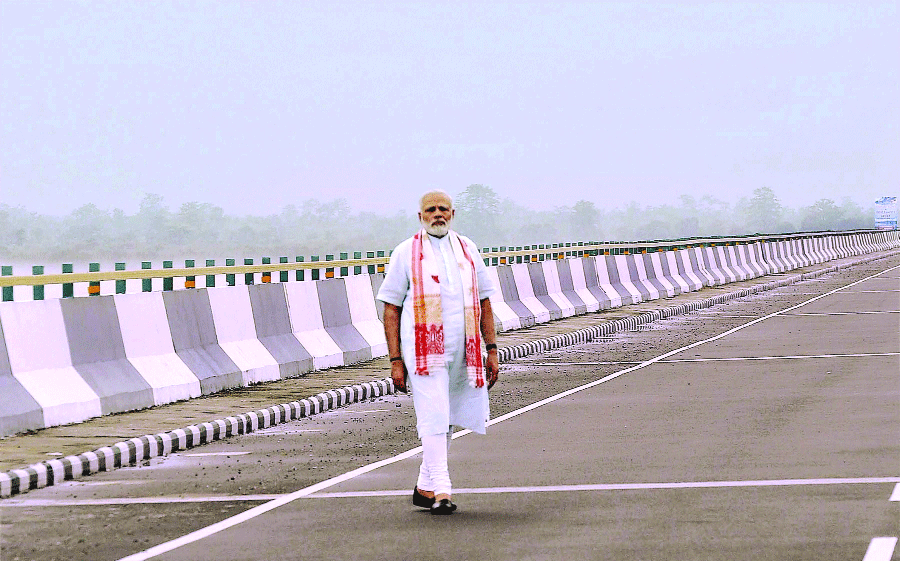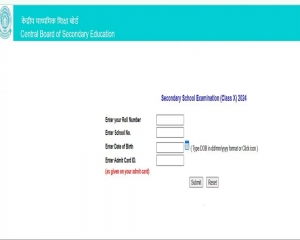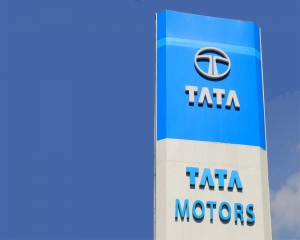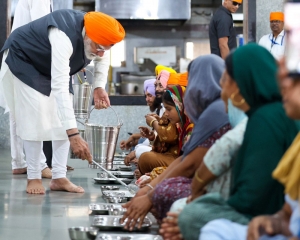Comment on India in the Chinese official/quasi-official Press, especially its policy approaches in foreign and strategic affairs, is always of interest in the country; all the more so now after India’s recent decision to stay away from the high profile ‘Belt and Road Forum’ (BARF). Excerpts from translations of some of the recent commentaries in Chinese are featured herewith
The translations are of value as indicators of Chinese (Communist Party elite) thinking on India and the world. Unlike the editorials, opinion pieces, etc, put out on the English language media platforms of China, the contents of these commentaries in Chinese published in the official/quasi-official newspapers are meant for domestic audiences. They, therefore, represent authentic perceptions of the Party that have been determined to be appropriate for being placed in the public domain for feeding Chinese public opinion.
The material put out on English language news platforms of China, in contrast, does not represent anything real. For it is content that the Chinese Party/State organs wish to project externally to global audiences (as their take on contemporary developments). It is not at all the same as what the Chinese people are told in the Chinese language domestic Press. In other words, it (the former) is sheer propaganda and, as such, deserves to be ignored.
Regrettably, however, it — the English language output of the Chinese media — is taken seriously and swallowed unexamined as the authentic view and voice of official China. The entire public discourse on China in India is, in fact, based on those hand-outs in English, without inclination or diligence to see them for what they are — prime vehicles for propaganda bluff and bluster. And unmindful, at the same time, of the vulnerability of readings and assessments made within that basic limitation (of the primary source material being in English) to manipulation — to the stratagems of deception and (psychological) domination through disinformation (and diversion of the enemy’s attention in desired directions, away from the true action centre) that are known to be essential instruments in the armoury of Chinese ruling classes schooled in “the art of war” by Sun Tzu.
Such a basic gap in the study of China is in dire need of correction, obviously.
The “From the Chinese Press’ feature is a modest attempt in that direction. It is brought to The Pioneer readers, courtesy National Institute of Advanced Studies, Bengaluru, where “India in the Chinese Media” project monitors the coverage of India (and its neighbouring counties) in selected dailies from the official and quasi-official Chinese Press on a daily basis. Any queries can be addressed to Ambassador Saurabh Kumar, who anchors the project, at saurabhkumar1610@gmail.com.
Full texts of the translations are available at www.niasindiainchina.in.
I. Global Times (Chinese) May 27, 2017)
Modi personally inaugurates bridge on India-China border
The 9.15-kilometre bridge is the longest bridge in India and is said to have shortened travel time between Assam in North-Eastern India to “Arunachal Pradesh” (China’s Southern Tibet region)… The geographic location being close to the Sino-Indian border, it is natural to analyse military uses of the bridge, and together with fact that Modi highlighted national pride and participated in the inauguration ceremony, the move acquires significance as a means of exercising pressure on China. Although Indian military sources said the bridge would help in resisting “unexpected action from China”, China experts in India told the “Global Times” in an interview that they believe that this is just an eye-catching argument. Ultimately, conflict with China does not help (serve) India’s real interest, its current hopes of vigorously developing the economy.
Emotional speech
…Modi’s speech is very
emotional…
Waking up to the challengeIJ
The Dora-Sadia Bridge is considered part of Modi’s ambitious Indian infrastructure programme, but because of its sensitive geographical location, many foreign media analysts point to the military value of the bridge. The Indian Express on May 26 said it was built to signal India’s strengthening military defence capabilities against China. The Army is the “most significant beneficiary” of the bridge. India’s “Economic Times” on May 26 said that the new bridge is India’s way of conveying to China to “stay away” (maintain distance).
...The Indian Express said that … Now, India’s delivery (time) of troops to “Arunachal Pradesh” will be reduced and it will… greatly enhance the Indian Army’s mobility.
As to the role of the Dora-Sadia Bridge, Indian officials do not shy away from mentioning China. BBC reported that India’s Deputy Interior Minister Kiren Rijiju said that China’s activities compel India to work overtime to strengthen the infrastructure in order to defend the country. Indian Interior Minister Rajnath Singh also stressed the importance of building infrastructure in Abang (literally A-province — Chinese shorthand for Arunachal Pradesh), saying it was part of defending the country’s long border with China.
“In the Indian political arena, there are still people with the 1962 Sino-Indian war defeat complex, and (they) even want to take revenge.” In an interview to “Global Times” reporter on May 26, Director of Shanghai International Research Center South Asia Institute of Central Asia Wang Dehua said that memoirs of defeated generals and other relevant documents reveal that one of the reasons for India’s defeat was the poor state of infrastructure in Southern Tibet and lack of access to information.
US Bloomberg said the Dora-Sadia Bridge was to ensure that the Indian Army could “enter the Southern Tibet region smoothly”. A former Indian Army Colonel said the construction of the bridge in the Sino-Indian border infrastructure represents a transformation (major change) in Indian Defence thinking: “the new infrastructure will help the Indian Army prepare to retaliate against Chinese adventures”. “India is now waking up to the challenge. We need infrastructure to transport troops and supplies, if we want to fight China,” said the BBC quoting retired Indian general’s words. Since the 1960s, India did not build infrastructure in the disputed area out of the “foolish” fear that a good (network of) border roads could be “taken advantage of” by the Chinese Army during time of conflict.
It is not difficult to see from the above mentioned remarks of Indian military figures that they believe that the Dora-Sadia Bridge is in preparation for a conflict between China and India. In Wang Dehua’s view, these are just eye-catching remarks, because “this bridge simply cannot play any (such) role.” Wang Dehua told the Global Times that some Indians still retain a cold war mindset. An Indian scholar has written a book anticipating that in “2017 China and India will definitely go to war”. Wang Dehua was in India and met the author. He laughed in embarrassment when asked “do you believe it” (yourself)IJ
“Dual policy” towards China
Modi’s ambitions in the disputed areas of China and India are not just to build the Dora-Sadia Bridge.
Apart from engaging in infrastructure construction, last month India also invited the Dalai lama to visit “Arunachal province”. The Chinese side protested strongly. Of late, controversies between the two countries over the border have become more frequent. Wang Dehua considers that India thinks that by these actions of forcing a showdown with China, it can make China yield concessions on the border issue. But it should be clear to India that problems cannot be solved by force: that will only hurt both sides, with India suffering far more (bleeding severely). “China and India cannot go to war. Conflict does not serve the national interest of India and China. India must resolve problems peacefully through dialogue.”
From military security to economic and trade strategy, India seems to have given a lot of thought lately to “contention” with China. A few days after conclusion of China’s “One Belt One Road” International Cooperation Summit in China, India advanced the concept of “Asia-Africa Development Corridor”, trying to push Japan’s “infrastructure corridor from Asia-Pacific to Africa”. Two days earlier, a number of the Indian media got excited at the (news of) United States reactivating two of its infrastructure projects in Asia. Wild speculation in the Indian media about the intention behind that news was also to counter China’s “One Belt One Road” initiative.
As to the series of actions and reactions in India, Peking University South Asia Research Center Director Jiang Jingkui told “Global Times” on May 26 that “even if India is really using the Asia-Africa Development Corridor to contain China, we do not have to engage in confrontation. China can actively use (its) “One Belt One Road” (initiative) to connect with it so that African friends will be all the more grateful to China. For (quite) some time, China should display a large heart as befitting a big power.”
In the third year of Modi’s rule, many Indian media also summed up his foreign policy on May 26. “Modi’s China policy shows some resilience of a “double whammy” — (treating) China both as a friend with a focus on improving relations with it and going all out (to give it back) while dealing with it on the diplomatic and strategic front. On the one hand, Modi invited Chinese leaders to visit his hometown to build a personal relationship; on the other hand, pursued the opposite (course) in some diplomatic and strategic issues, such as trying to win over the Maldives, Sri lanka and other small neighbours and Southeast Asian countries as well as going hand in hand with China’s traditional rival, Japan.
In an interview with the Global Times, Wang Dehua said India’s foreign policy has a certain continuity, “because of its civil service system of governance... So Indian politics does not depend on a particular leader coming to power and making fundamental changes”. In relations with China, because many of some of India’s elite and the military have Western education and influence, so the United States, Japan and other countries exert a pull and India’s relations with China will change. But on this issue, there are debates within India; some people advocate not to show an “arrogant India(n)” face to China. Jiang Jingkui said that upon assuming office, Modi attached importance to attracting investment. He understood that this was inseparable from China, and that only by drawing in the United States, Japan and other countries could China be counter-balanced.
“There is little chance of further (continued) deterioration of India-China relations. There will be a turn around. After all, India realises the turn (back on track) in China-US relations, and the stability of Sino-Russian relations”, said Wang Dehua summarising the future of Sino-Indian relations. Hindustan Times observed that Sino-Indian relations cannot be represented by one or two issues (only); both countries are aware of this. There has to be more responsible cooperation between these major powers, for the sake of the interests of the people.
II. Global Times (Chinese) May 26, 2017)
Afro-Asian Development Corridor is no match for the Belt and Road
Indian Prime Minister Modi tried to push the joint India-Japan Asia-Africa Development Corridor… at the African Development Bank Summit Conference held in India on May 23. Indian and some Western media have argued that the two countries are trying to check China’s “One Belt One Road” initiative. As India is the only country that has publicly questioned “One Belt One Road”, New Delhi’s geopolitical attempt (initiative) around the Asia-Africa Development Corridor has received more attention.
The (smooth) development of Sino-Indian relations has been withheld by some old and new problems. New Delhi has been disturbed unduly, both in words and deeds. But if we step back and think it over coolly, compared to the highs and lows of earlier decades, Sino-Indian relations have been much more stable (in recent times). Not only is there tranquility in the border areas, but growth in trade has also been maintained. That apart, no sudden crisis broke out to affect the overall situation between the two countries (on the border).
India likes to be compared with China for anything and everything. In these last years, India has come out with ideas of “monsoon plan”, “spice road” and so on, which presents a confused picture of cooperation before the world. The Indian media love to play this against China’s “One Belt One Road” proposal… This seems to help Indians bolster their confidence in the wake of the “One Belt One Road” (initiative).
However, seeking truth from facts, there is no way “Asia-Africa Development Corridor” can compare with “One Belt One Road”. The latter has secured wide recognition/acceptance, even the United States and Japan have turned to a positive attitude towards it. In addition, “One Belt One Road” has already achieved a lot of results, and held its first Summit forum, whereas the “Asia-Africa Development Corridor” is still at the “blueprint” stage.
Unlike China, India still has a huge funding gap in relation to infrastructure. Its infrastructure capacity is far from the stage of spilling over (surplus) naturally. China’s “One Belt One Road” is out and out a development initiative that is on course, while the “Asia-Africa Development Corridor” stems from Indian geopolitical considerations. It has hastily come out with a joint “counter strategy” with Japan.
In fact, even if India and Japan can work out something of the kind (“Asia-Africa Development Corridor”), there will be hardly any negative impact on China. There are many development plans in the world; they overlap and the possibility of their docking with (dovetailing into) each other seems to be more than the chances of rejection (of each other). As for the possibility of a little more competition, the Chinese people are least bothered. Competition in the world today is everywhere. India’s GDP is less than 1/4 of China, and at least at present it cannot be a key factor influencing the macro- environment for competition.
Therefore, China has the psychological capacity to prepare (itself) for welcoming the success of the India-Japanese “Asia-Africa Development Corridor”, and even if some Chinese people would be inclined towards conflict with India, Chinese society has the collective ability to restrain such sentiment.
India feels (an inexorable) need to jump ahead of reality (facts on the ground) and psychological anxiety to be compared to China. It need not seek to feel good by advertising its innermost fears and insecurities before the world. It may wish to relax a little and calm down. China has never squeezed India’s strategic space. It has offered itself as a natural partner for India’s economic development. It will never be a stumbling block (for India). China is willing to continue to widen the sphere of congruence between the two countries; it does not intend to engage in a zero-sum game in any arena.
India is driven by anxiety towards China, and if it makes competition with China a major plank of its national development strategy, then it will harm itself. Because the strategy would be targeting a problem that does not exist, it will tire itself out in the course of the implementation, and ultimately only benefit interested third parties.
Some Indian elites, forever interpreting Sino-Indian relations against the world map, always find China and India “encircling” each other. They are full of geopolitical vocabulary, but yet childish and naïve like student essays. (It is worth) recalling that in recent years, Indian leaders have repeatedly told the Chinese side that “Asia has enough space to accommodate the rise of both China and India”. We have reason to believe that their words are objective and sincere. Because expansion of cooperation between China and India is more beneficial to India than to China and India can harvest much more benefit through cooperation with China, rather than by countering it. It should not be difficult to figure out these pros and cons.
III. Global Times (Chinese)
May 26, 2017
What is India’s intention in establishing tsunami warning systems in the South China SeaIJ
“India plans to set up a tsunami warning system in the South China Sea”, the Times of India reported on May 24, in order to strive for greater influence in the South China Sea, India is exploring the early warning system in the South China Sea to establish the possibility of early warning system. The report said that China is also establishing a tsunami warning centre in the South China Sea. China’s official media reported in May that the tsunami warning centre in the South China Sea established by China was already operational initially.
The Times of India says India’s early warning system will issue early warnings on tsunami to Vietnam, Thailand, Malaysia and other countries along the South China Sea coast. India’s Secretary of the Earth’s Science Department of Madhavan Nair Rajeevan told the newspaper that India already has a system of issuing tsunami warnings to Southeast Asian and South Asian countries. “India is the Chairman of RIMES (Integrated Early Warning System for Integrated Multi-Disaster in Asia and Africa). We are also a major resource contributor, and we are exploring the possibility of establishing a tsunami early warning system in the South China Sea,” he said.
It is reported that India has economic interests in the disputed waters of the South China Sea, especially in offshore oil exploration wherein Indian and Vietnamese oil companies have economic interests. Indian Minister for External Affairs Singh VK Singh has said that more than 55 per cent of India’s trade passes through the South China Sea and Malacca Straits. “The early warning system for tsunamis has not yet been officially approved,” said Rajeevan, “if the project is implemented, warnings will be released through the RIMES system, and Vietnam, Thailand and others will benefit from it.”
Pacific Association Deputy Secretary-General Yu Zhirong told the Global Times in an interview on May 25 that this is a manifestation of India meddling in South China Sea affairs. The South China Sea is not an open sea like the Pacific and Indian Oceans. Tsunamis generally do not happen there. But even if it is required, there is the South China Sea tsunami warning centre established by China with approval of the concerned organs of the UN; there is no need for intervention of countries outside the region.
IV. Global Times (Chinese)
May 26, 2017)
Disconnect between India’s “superpower ambition” and its real strength
The opportunity of hosting the African Development Bank meeting from May 22 to May 26 was utilised by India to hitch itself to Japan’s “Asia-Africa Growth Corridor” plan. The plan also has a well-known code name — “Freedom Corridor”. Some Western and Indian media are also trying to link the plan with China’s “One Belt One Road” initiative, which is an attempt (by them) to get India to try to balance China’s “One Belt One Road” because it (the latter) also aims to connect Europe and Asia.
“Freedom Corridor” plan reveals a “sour grapes” psychology
In fact, as early as Indian Prime Minister Modi’s visit to Tokyo last November, Japanese Prime Minister Shinzo Abe announced that they “will promote the extension of the Freedom Corridor from Asia to Africa”. Indian Finance Minister Arun Jaitley recently visited Japan to discuss “Freedom Corridor” cooperation and other related issues with Japan once again. This time, India and Japan chose to recommend their “Freedom Corridor” plan to African countries soon after conclusion of China’s “One Belt One Road” Summit Forum, “more and less” with some “sour grapes”.
As an article in the India’s Economic Times says, India and Japan have decided to launch a diversified infrastructure programme from Asia-Pacific to Africa, the so-called “Freedom Corridor”, in the face of China’s “One Belt One Road” corridor programme, to work together to build a number of infrastructure projects in Africa, Iran, Sri lanka and Southeast Asian countries to balance China’s regional outreach.
Is the Indo-Japanese “Freedom Corridor” plan (just) an attention attracting sloganIJ It seems not, for there are quite a few action points. Such as: the two countries decided to undertake joint ventures in East Africa in infrastructure and capacity-building projects; Japan will also participate in India’s important strategic Chabahar port and “coastal special economic zone” plan in Iran, the Trincomalee port in eastern Sri lanka. At the same time, the two countries may also jointly develop the deep sea port of Sittwe on the border between Thailand and Myanmar.
During the meeting of the African Development Bank, India and Japan met the African Development Bank Member States to discuss joint development projects such as infrastructure and capacity building in order to promote the “Freedom Corridor” program from Asia Pacific to Africa, while strengthening contacts with India and Japan.
The conference was hosted in Modi’s hometown, the city of Ahmedabad, which is the ancient capital of Gujarat, India. It is evident that there has been a surge in India’s “great power ambitions” after Modi came to power, but “great ambitions” can be sustained only on a strong foundation of economic strength. In recent years, India’s economic development has been rapid indeed, with GDP growth rate of about 7 per cent. In 2016, total economic output reached 2.09 trillion US dollars, about a fifth of China’s, but India’s infrastructure is very deficient and the level of construction capacity manufacturing is also low likewise.
Not surprising that India sees Africa as its “backyard”
Africa has always had a special place in the eyes of Indians, the Indian Government has attached great importance to Africa, and some people even see Africa as India’s “backyard.” At present, some of India’s enterprises in Africa are minor celebrities. India’s “Tata” brand car can be seen everywhere in the streets of Johannesburg, South Africa’s economic centre. In addition to the Government’s “Africa Focus” programme, India itself has many traditional advantages. Therefore, India regarding Africa as its “backyard” is not surprising.
First, from a historical point of view, India attaches importance to and utilises its “kindred” ties with Africans of Indian origin, Indians in Africa and Commonwealth Indians in these countries. There are 2.8 million (such) Indians in Africa, mainly living in South Africa, Kenya and Tanzania. India uses their connections with the Commonwealth to deepen relations with Africa.
Second, India often emphasises its geo-political and democratic links in working its way in Africa. The Indian Ocean is the “Indian backyard” connecting India and Africa. India has always attached importance to peacekeeping operations in Africa. The Indian Navy is also very influential in Africa, and many countries along the Indian Ocean with Navies having military relations with India.
Further, India attaches great importance to its expertise in information technology, as well as the use of seasoned private enterprises, to moderate the downside of the country’s entry into Africa. India has officially launched the Pan African Electronic Network Connectivity Programme. Plans to connect India and 53 countries of the African continent through satellite and fibre cables.
But even with so many factors and measures, Africa is clearly not “India’s Africa.” Some media believe that geopolitical factors must not (be allowed to) infiltrate the India-Japan “Freedom Corridor” initiative cutting across from the Asia-Pacific region to Africa, as that would result in a kind of unhealthy competition.
The author believes that there is a disconnect between India’s great power ambition and its current strength. It would be an extremely unwise move for India and Japan to look upon the “One Belt One Road” initiative advocated by China in antagonistic terms. On the basis of his interaction with people from all walks of life in India, the author considers that the main reason for reservations (on the part of many in India) on extension of the “One Belt One Road” to India is their view that “China does not accord any special consideration to issues that are sensitive for India”. These being not only the iconic project of the “One Belt One Road”, the China-Pakistan Economic Corridor, crossing disputed territory but also the armed opposition groups in India’s North East, which are a major security concern for India and on which cooperation in China with these areas is not easy, naturally.
However, India also has a lot of China scholars and experts who advocate that the “One Belt One Road” should be extended to India and that “China and India should (engage in) dialogue, and not harbour distrust”. India’s officialdom adopts an attitude of indifference towards the “One Belt One Road” but the “big power mentality” comes in the way. It can neither resolve the border problem left over by history nor fundamentally do away with “security concerns”. India must emancipate the mind, change its thinking and mentality, and remove the psychological fear of China through dialogue, relating/connecting and exchanges. Harbouring suspicions will only worsen China-India relations.
V. Global Times (Chinese)
May 25, 2017
Indian Prime Minister makes a sensational speech to draw Africa
“In the sports arena, India cannot compete with Africa in long distance running. But I can assure you that India will always stand with you, shoulder to shoulder, supporting you in the long and difficult race for a better future”. Indian Prime Minister Modi’s emotional speech at the opening ceremony of the annual meeting of the African Development Bank held in Gujarat attracted warm applause. The Indian Express noted that India had put forward the concept of the “Asian-African Development Corridor” a few days after conclusion of China’ International Forum on the “One Belt One Road” initiative, and now the proposal has become an important part of Modi’s speech. India is striving to deepen India-Africa relations to counter China’s growing influence in Africa.
From the May 22 to May 26, nearly 3,000 delegates from Africa gathered in Gujarat. This is the first time that the African Development Bank Conference is held in India. “You took up our battles as if they were your own,” Modi brought out Nelson Mandela’s evocative words of the time in his speech of May 23, while touching upon the history of India-Africa relations. On becoming the Prime Minister of India, he went to almost every African country to emphasise that the relationship between the two sides had grown by leaps and bounds today.
“Indian business online” website commented that India is clearly focused on ensuring a sense of presence in Africa to counter China’s “peaceful offensive.” Modi said that India is working with the United States and Japan to jointly support Africa’s development. Press Trust of India said the annual budget released by the Trump Government on August 23 revealed the allocations of two infrastructure projects — the “New Silk Road” through Afghanistan and neighboring countries and the Indo-Pacific Economic Corridor linking South and South-East Asia. It is believed that India will play an important role in both.
On May 24, Japan and India separately met African Development Bank member countries to discuss joint development plans for local infrastructure and capacity building. Japan’s “New Sphere” website commented that this is (a manifestation of) the two countries promoting the idea of economic circles (regions) by trying to build an economic corridor extending from the Asia Pacific to Africa.
China Southern Asia Association Executive Director Qian Feng told the Global Times on May 24 that there is no conflict or major contradiction between India and Japan; both countries have weighty reasons to contain China, and the relations between them are at their historical best, so in this matter it is easy for them to hit it off. Joining hands together, Japan and India can make up for each other and promote their plans in Africa more effectively. But as to whether the two countries will be able to work together to contain China, Qian Feng believes that China has earned goodwill of a lot of people in Africa through practical things (action), and it will not be easy for Western countries to “squeeze out” China’s influence. But the trends in the Indo-Japanese (duet) in Africa need to be watched closely.


























